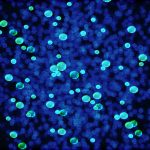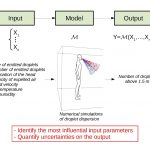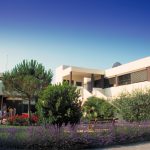December 15th, Seminar by S. Thalabard
- When: Wednesday, December 15th, 2021 at 11:00 (CET)
- Where: Coriolis (Galois building)
- Speaker: Simon Thalabard (University Côte d’Azur)
- Topic: From random trajectories to random fields: Is fluid dynamics intrinsically random?
- Abstract: This talk intends to briefly introduce the mechanism of spontaneous stochasticity, a radical version of chaos emerging within turbulent environments. Roughly said, the spontaneous stochasticity describes the finite-time emergence of macroscopic randomness out of thermal fluctuations, due to the presence of some type of small-scale roughness. I will specifically discuss two simple frameworks where spontaneous stochasticity can be identified, namely the turbulent diffusion of fluid particles and the Kelvin-Helmholtz shear-layer instability. Those two examples suggest that fluids at high-Reynolds number are intrinsically random objects, be them observed from the Lagrangian or from the Eulerian perspective.
November 18th, Seminar by A. Bianco
- When: Thursday, November 18th, 2021 at 10:00 (CET)
- Where: Coriolis (Galois building)
- Speaker: Angelica Bianco (LaMP/CNRS, Université Clermont Auvergne)
- Topic: Organic matter in the atmosphere: from micro and nanoplastics to cloud chemistry
- Abstract: This seminar will firstly focus on the presence of micro and nanoplastics in the atmosphere, with a brief introduction of the experimental determination of the concentration and the technological limitations. The second part will be focused on reactivity, especially concerning the aqueous reactivity with hydroxyl radicals. in the last part we will explore more the composition and transformations happening in atmospheric droplets and their impact on pollution and climate.
November 10th, Seminar by C. Brouzet
- When: Tuesday, November 10th, 2021 at 10:00 (CET)
- Where: Coriolis (Galois building)
- Speaker: Christophe Brouzet (CNRS InPhyNi)
- Topic: Fragmentation of brittle fibres in turbulence and CO2 convective dissolution in a 3-D granular porous medium: two experimental studies
- Abstract: In this seminar, I will talk about two experimental works that I have performed recently.
In the first part, I will discuss the fragmentation of brittle fibres in a turbulent flow, motivated by fundamental questions related to the fate of plastic debris in oceans. Using laboratory experiments complemented by numerical simulations and theoretical analyses, our results demonstrate that the fragmentation process is limited at small scales by a physical cut-off length. This length originates from the fluid-structure interactions between the debris and the surrounding turbulent flow field, and is shown to be independent of the brittleness of the fibres. Such limitation mechanism of the fragmentation process at small scales is able to reproduce the size distribution of floating plastic debris measured in the ocean.
In the second part, I will present recent results on CO2 convective dissolution in a 3-D granular porous medium, related to the geological storage of CO2 in deep saline aquifers, a promising technique to mitigate global warming. When CO2 is injected in the geological formation, it dissolves partially in the interstitial brine, thus rendering it denser than the CO2-devoid brine below, which creates a convective instability. The instability has been intensively discussed by numerical and theoretical approaches at the Darcy scale, but few experimental studies have characterized it quantitatively. Our experimental measurements of the onset characteristics of this instability in a 3-D porous medium highlight that the growth rate of the instability is in clear discrepancy with the theoretical predictions, while the front of the instability exhibits a multi-scale nature. These results are consistent with a forcing of convection by porosity fluctuations, recently described in a theoretical model.
July 2nd, Seminar by M. Binois & A. Cousin
- When: Friday, July 2nd, 2021 at 10:00 (CET)
- Where: Coriolis (Galois building)
- Speakers:
- Mickael Binois (researcher in Team Acumes, Inria Sophia Antipolis)
- Areski Cousin (professor at IRMA Université de Strasbourg)
- Topics:
- Analysis of complex simulation experiments with Gaussian processes
- Beyond Surrogate Modeling: Learning the Local Volatility via Shape Constraints
- Abstract:
- We present an overview of the use of Gaussian processes as surrogate models for expensive-to-evaluate black-boxes. In particular, we focus on calibration (inverse problem) and uncertainty quantification, illustrated by several application examples from various domains.
- We explore the abilities of two machine learning approaches for no-arbitrage interpolation of European vanilla option prices, which jointly yield the corresponding local volatility surface: a finite dimensional Gaussian process (GP) regression approach under no-arbitrage constraints based on prices, and a neural net (NN) approach with penalization of arbitrages based on implied volatilities. This presentation will focus on the GP approach. We demonstrate the performance of these approaches relative to the SSVI industry standard. The GP approach is proven arbitrage-free, whereas arbitrages are only penalized under the SSVI and NN approaches. The GP approach obtains the best out-of-sample calibration error and provides uncertainty quantification, which is useful for the assessment of model risk. The NN approach yields a smoother local volatility and a better backtesting performance, as its training criterion incorporates a local volatility regularization term.
June 3rd, Seminar by R. Valette
- When: Thursday, June 3rd, 2021 at 10:00 (CET)
- Where: Coriolis (Galois building)
- Speaker: Rudy Valette (professor in Team CFL at CEMEF Mines-ParisTech, Sophia Antipolis, France)
- Topic: Modeling and numerical simulations of fluid flows with complex rheology
- Abstract: Heterogeneous fluids (pastes, granular, suspensions, emulsions…) generally present a strongly non-Newtonian rheology. They flow very differently from fluids such as air, water or honey. We will show various examples of flows (stretching or compression of filaments, jets, collapses, extrusion…) showing instabilities related to their rheology and discuss with the help of experiments, numerical simulations and simple theoretical analysis the mechanisms involved in these flows. Several examples will be proposed and the interest of numerical simulation will be underlined, both for the understanding of simple phenomena, but also for the prediction of more complex flows, such as those encountered in industry or in nature.
May 6th, Seminar by A. Seminara
- When: Thursday, May 6th, 2021 at 10:00 (CET)
- Where: Coriolis (Galois building)
- Speaker: Agnese Seminara (CNRS researcher at Institut de Physique de Nice, France)
- Topic: Sensory navigation using turbulent odor cues
- Abstract: Organisms use a variety of sensory cues to navigate to targets like food or mates, and to escape predators. Chemical and mechanical signals are carried long distance by fluid flows, but at the same time they are often distorted and broken in intermittent patches by turbulence. Here we draw inspiration from olfactory navigation in octopuses and mice and ask how can organisms predict the location of a target, using its turbulent odor cues. I’ll show how tracking odor cues for few seconds is sufficient to make predictions, if care is taken into quantifying both intensity and timing of odor detections. I’ll map our predictions on our preliminary data of odor representation in the mouse brain.
April 8th, Seminar by J. Yon & J. Moran
- When: Thursday, April 8th, 2021 at 10:00 (CET)
- Where: Coriolis (Galois building)
- Speakers: Jérôme Yon (researcher at Dept. Optic & Laser, CORIA, Rouen, France) and José Moran (PhD student at Dept. Optic & Laser, CORIA, Rouen, France)
- Topic: Simulation of the formation of soot particles: toward a better characterisation of these particles
- Abstract: Soot particles are formed due to the incomplete combustion of flames. These particles are not spherical and display a range of fractal morphologies that have to be take into account in various situations (metrology, transport, deposition, …). Tools based on laser metrology are being developed at CORIA to characterize such particles with in-situ measurements. A precise characterisation requires to accout for the fractal morphology of aggregates. To that extent, a code has been developed (called MCAC, for Monte Carlo Aggregation Code) to compute realistic soot aggregates. In this seminar, we will present the issues related to the characterisations of such particles using optical techniques as well as the principle of MCAC. Recent results obtained with this code will also be presented.
March 11th, Seminar by G. Lecrivain & C. Henry
- When: Thursday, March 11th, 2021 at 10:00 (CET)
- Where: Coriolis (Galois building)
- Speakers: Grégory Lécrivain (researcher at the Institute of Fluid Dynamics, HZDR, Germany) and Christophe Henry (researcher at Team CaliSto, Inria Sophia-Antipolis, France)
- Topic: Particle resuspension from monolayered deposits: evidence of collision-induced phenomenon
- Abstract: We present here new experimental and numerical results for the resuspension of microscopic glass particles from a monolayer bed into a turbulent gas flow. With an intermediate surface coverage, here about 10 % of the field of view, we report two distinct detachment mechanisms: collision-induced resuspension at low flow velocities and individual particle resuspension at higher fluid velocities.
February 11th, Seminar by F. Marcotte
- When: Thursday, February 11th, 2021 at 10:00 (CET)
- Where: Coriolis (Galois building)
- Speaker: Florence Marcotte (researcher at Team Castor, Inria Sophia-Antipolis, France)
- Topic: Corrola from drop impacts on viscous fluids
- Abstract: The study of substrates of varying viscosity is motivated by the desire to reconcile abundant observations of drop impacts, which in the literature highlight very diverse splash dynamics, on the one hand for impacts on solid substrate, on the other hand for impacts on liquid substrate. Varying the substrate viscosity over several orders of magnitude allows to capture the transition from a splash-on-liquid to a splash-on-solid regime, and to clarify the role of the substrate in the formation of the impact corolla.
January 14th, Seminar by A. Dupré
- When: Thursday, January 14th, 2021 at 10:00 (CET)
- Where: Coriolis (Galois building)
- Speaker: Aurore Dupré (post-doc at Team Calisto, Inria Sophia-Antipolis, France)
- Topic: Uncertainty quantification in CFD simulations of multiphase flow
- Abstract: In this work, we present recent advances that have been made within the framework of the VIMMP project (Virtual Materials Market Place). We start by introducing the workflow studied (including both the physical aspects, the modelling approaches retained and the numerical tools used). Sensitivity analysis tools are then presented and used to identify the key parameters affecting the observed results.





